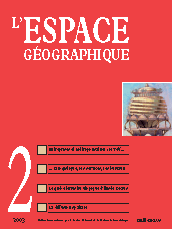

The greater French South-East: a strategic space in a spatio-logistical recomposition in Europe? (2 fig.)
In line with the economic and geopolitical transformations currently underway, the geography of stocks and flows is undergoing a major recomposition in Europe. In the greater French South-East, a geo-logistical mosaic, the gap between well-serviced and neglected areas has widened during the last 25 years, favouring larger conurbations.
In this context, the purpose of this paper is to highlight the broad range of processes contributing to a multi-scale reorganisation of the spatio-logistical system in the area under consideration. These changes need to be taken into account in the political debate on rural and urban planning.
keyword: GREATER FRENCH SOUTH-EAST, LOGISTICS, RURAL AND URBAN PLANNING, SPATIAL RECOMPOSITION, TRANSPORT
High speed and social hierarchy: metropolitan work as a spatial analysis tool (3 tabl., 2 fig., 2 encadrés)
The concept of metropolitan work developed by the Geography of the Productive System team at Strates Laboratory is used in this paper to re-interpret the results of mobility surveys conducted on passengers of two high speed railway lines. Firstly, this segmentation of the working population, rather than the GCV, highlights a dynamic aspect of social differentiation related to metropolisation and globalisation. In a second stage, these results are spatialised. Business travel analysis shows an inter-urban structure, which represents both a hierarchical network of metropolitan activities and the domination of metropolitan space over banal space. Starting from data that are not especially prepared, the concept of metropolitan work produces a picture very close to that proposed by the principal analysts of the metropolitan phenomenon. It appears to be a highly operational and powerful tool for spatial analysis.
keyword: BUSINESS TRAVEL, HIGH-SPEED TRAIN, METROPOLITAN WORK, METROPOLISATION
Anne AGUILÉRA. The location of business services in the Lyon metropolitan area (France): between centrality and diffusion (6 tabl., 2 fig.)
This paper deals with the location of business services inside the metropolitan area of Lyon on the basis of statistical data and a survey. The significant suburbanisation is a result of new business creation rather than transfers of existing businesses from the centre. This suburbanisation is closely connected to the configuration of transport infrastructures and the suburbanisation of customers. But the metropolitan centre still holds a strong attraction. Its specific advantages are the large potential customer base, the high-speed train (TGV) station and the prestigious address. Location strategies depend, however, on the types of business services and contribute to maintaining disparities between the centre and the periphery and between the east and the west of the metropolitan area.
keyword: BUSINESS SERVICES, CENTRALITY, LOCATION, RHÔNE-ALPES, SUBURBANISATION
Éric CROUZET. The office property market and metropolitan territories: accentuating territorial discrimination.
This paper highlights the links between the property market and metropolisation. In particular, it shows how the office property market fosters metropolisation, urban hierarchisation and the functional dualisation of the urban economy.
A historical analysis of office property production in Toulouse and Bordeaux shows that the trend in the property market is related to a speculative process based on a quasi-performative marketing discourse. We realise that the business property sector can create market trends that are disconnected from the local economic realities of a metropolis. In this sense, it represents a formidable economic power, able to create positive or negative territorial discrimination, depending on whether the market is in euphoria or crisis.
keyword: BORDEAUX, CRISIS, GLOBAL CITY, MARKETING, METROPOLISATION, PROPERTY MARKET, TOULOUSE, URBAN SEGREGATION.
Soizic ALAVOINE-MULLER. A globe for the Universal Exhibition of 1900. The geographical utopia of Élisée Reclus (4 fig.)
For the Universal Exhibition of 1900, Élisée Reclus proposed a singular monument: an enormous Globe of the Earth, a perfect replica of the real Earth. The monument was intended as a showpiece that would popularise geography and change peoples perceptions of the Earth. Because the globe is the only representation that offers complete truth, the geographer thought it would replace geographical maps. Financial and ideological obstacles prevented the monument from being built. Recluss idealism and scientific views were too far removed from the aims of a universal exhibition. The exhibit that he had wanted to be permanent was left out of the ephemeral ostentation of 1900.
keyword: CARTOGRAPHY, ÉLISÉE RECLUS, GLOBE, POPULARISATION, REPRESENTATION, UNIVERSAL EXHIBITION, UTOPIA
Reconstitution of a spatial diffusion from a state sequence (2 tabl., 8 fig.)
This paper aims to define the progress of a spatial diffusion process. It seeks to reconstitute the flows between spatial units, on the basis of state variables alone. The first step consists in estimating the most appropriate spatial distance, in order to describe the change from one date to another, by using a variographical analysis or a spatio-temporal co-occurrence matrices analysis. In the second step, the flows and barriers are reconstituted on the basis of the potential differences between each couple of units linked by the chosen distance. Because of the specific topological context of each unit, emission and reception indices are proposed for the flows and barriers. This method is applied to pullulation data for the common vole in the municipalities of the département of Doubs (France).
keyword: BARRIER, CO-OCCURRENCE, FLOW, GEOSTATISTIC, SPATIAL DIFFUSION, STATE VARIABLE
In this issue of l’Espace géographique, you will find critical reviews of the following books:
VALENTINE Gill (2001). Social Geographies: space and society. Harlow: Prentice Hall/Pearson, coll. 400 p., ISBN 0 582 35777 2, par Hugh Clout sous le titre: Prepared for a shock?
L’espace géographique 1/03![]()
![]() L’espace géographique 3/03
L’espace géographique 3/03
For subscribe or buy this issue: BELIN
![]() L’Espace géographique: contents
L’Espace géographique: contents
Last modified: June 18, 2003